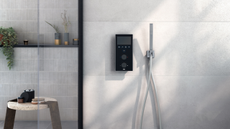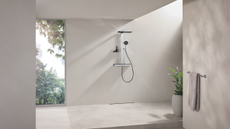Tech
Latest
-

If You're Looking for a Portable Speaker That Packs a Punch, I Tested Bose's Most Powerful Bluetooth Device and Gave It a Near Perfect Score
It's loud, durable, and stylish, but is Bose's top portable Bluetooth speaker worth its high asking price?
By Britta O'Boyle Published
-

Hisense Canvas TV Review — "You're Getting a Beautiful TV That's (Arguably) Worth More Than You Paid for It"
I tested the big challenger in the 'TVs that look like artworks' market — but does it stand up to the competition?
By Hugh Metcalf Published
-

Wait, What Actually Is a 'Digital Shower System'? The Pros and Cons of Tech-Enhanced Showering, Explained
Is this the shower of the future? Or just another way to waste your money? The experts are here to let you know
By Maya Glantz Published
-

Samsung vs Sony — Which of These TVs Is Best to Buy in 2025? Our TV Expert Has Come to an (Updated) Verdict
Versus Choosing between Samsung and Sony TVs? Both are top-notch, but which is best for you? Let's weigh the options and find out.
By Luke Edwards Last updated
-

Samsung Just Launched The Frame Pro TV — But What's Different From The Frame, and Is It Worth Upgrading?
There’s a new Frame in town, and it might finally get videophiles on board
By Alan Martin Published
-

Samsung Just Launched "Vision AI" Which Promises to Make Your TV Smarter — But What Does It Actually Do?
Samsung’s new AI-packed TVs start at $499.99 and have plenty of tricks up their sleeve
By Alan Martin Published
-

5 Smart Bathroom Tech Trends to Adopt in 2025 That Make This Space Such a Joy to Use
Still got a regular flush toilet? Yawn... Upgrade your space with the tech trends that are the future of modern bathroom design.
By Maya Glantz Published
-

Forget Air Fryers, This Is the Cleverest Smart Kitchen Tech to Make Cooking Easier and Quicker
If time is your biggest hurdle in cooking delicious meals, these smart oven features will help you make meals so much faster, no air fryer required
By Maya Glantz Published
-

6 Kitchen Appliance Trends to Invest in for 2025 — 'Built-in' Airfryers, AI Ovens, and Fridges That Make Food Last Longer
It's time to level up and buy into these innovative, stylish kitchen appliances
By Maya Glantz Published
-

Amazon's New Echo Spot Is Its Best Looking Smart Speaker With a Screen — And It's Almost Half Price Right Now
The newest design of this Alexa-enabled device fits into your home more naturally than many of its predecessors
By Hugh Metcalf Published
-

How Do You AirPlay to a Fire Stick? Stream From Phone to TV Seamlessly With This Hack
Amazon’s Fire TV Stick doesn’t support Apple AirPlay, but there’s a passable workaround available. Read on to find out what it is
By Alan Martin Published
-

AirPlay Not Working? Here’s How to Troubleshoot When You're Unable to Connect Your Apple Device
Some handy tips on things to try in order to get AirPlay up and running again
By Alan Martin Published
-

7 Smart Home Mistakes Our Expert Says You Shouldn't Still Be Making
Some key errors to avoid if you want a trouble-free smart home in 2024.
By Alan Martin Published
-

This $10 "Snug Plug" Gadget is a Simple Way to Fix Loose Outlets in Less Than a Minute
If you're tired of your devices falling out of your outlet this tiny gadget is the remedy you need
By Lilith Hudson Published
-

9 iMessage Tricks That Will Help you get the Most out of Your iPhone's Texting Services
Get the most out of iPhone-to-iPhone messaging with these advanced tips.
By Alan Martin Published
-

5 Clever Ways you can use Your Amazon Alexa Devices to Help you Sleep Better — 'They Revolutionize Your Night Time Routine!'
If you don't have an Amazon Echo device in your bedroom yet, you'll definitely want to after learning about these genius functions
By Lilith Hudson Published
-

5 Smart Things That Also Make Your Home More Cheerful — "It'll Shake off the January Blues!"
The joy of a smart home it that it can also make you extra joyful, too. These 5 bits of tech will help you beat the January blues by making your decor more cozy
By Alan Martin Published
-

These are the 6 Smart Home Gadgets Worth Investing in - 'Even Technophobes Will Love Them!'
Even the less tech-savvy among us can learn to love these clever pieces of kit
By Lilith Hudson Last updated
-

Should I get a smart assistant with a screen? The reasons our tech expert upgraded his home, and the best deals
Plenty of people won’t need their smart speaker to have a screen, but for some, it’s an extremely handy upgrade
By Alan Martin Published
-

Is my TV too high on the wall? The golden rule to use for a more comfortable watching position
While it’s ultimately down to personal preference, there’s some conventional wisdom about how high you should wall mount your TV.
By Alan Martin Published
-

What are the best TV settings for watching sports? This is what our expert says to tweak, and what to never touch
Make your sports look their best by tweaking your TV settings for the best picture possible
By Alan Martin Published
-

How to set email reminders on iPhone - the best kept secret for keeping your inbox under control
Apple Mail’s reminder function for iPhone lets you deal with emails when you’re good and ready. Here’s how to do it
By Alan Martin Published
-

How to use 'text replacement' on your iPhone – plus genius ideas for how this handy feature can make your life easier
Don’t waste time repeatedly typing out phrases you use all the time. With the iPhone text replacement feature, you can shortcut them for quick use
By Alan Martin Published
-

10 hidden iPhone tricks you probably don't know about – all designed to put more power in your pocket
Your iPhone can do a lot more than you think. Here are 10 skills you may not be aware of
By Alan Martin Published
-

Apple's new 'Voice Isolation' will make your call quality on an iPhone a million times better – here's how to turn it on
Voice Isolation minimizes background noise to make call quality sound better than ever on iPhone. Here’s how to enable it.
By Alan Martin Published
-

10 genius uses for NFC tags – the Amazon buy that costs less than $10 and will make your smart home so much smarter
Make your smart home even smarter with these clever uses for NFC stickers
By Alan Martin Published
-

How do I set up a smart home? These are the 10 steps to take to automate your house from top to bottom
Starting small, we show you the ten steps to make your house a smart home.
By Alan Martin Published
-

Soundbar mounting ideas to enhance your TV's audio
Soundbar mounting ideas to redefine Friday night at the flicks, stream your favorite music and upgrade your room schemee
By Emily Peck Last updated
-

How to mount a soundbar on a wall for a fabulous music and TV experience
Find out how to mount a soundbar on a wall and upgrade your TV's audio this season
By Emily Peck Last updated
